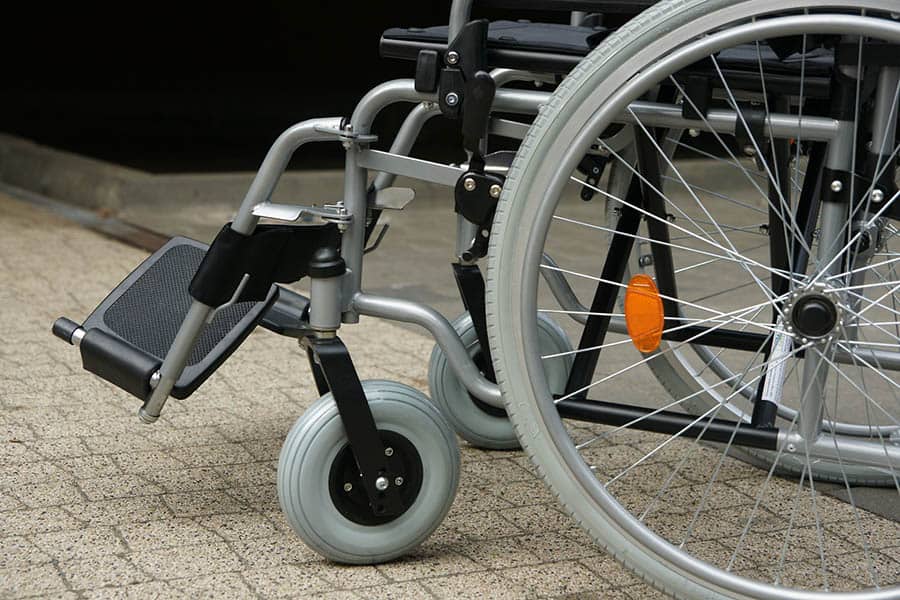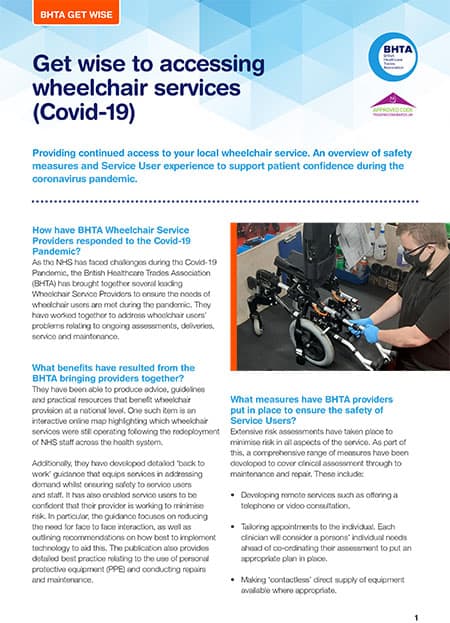BHTA works with key member companies to produce new guide on accessing wheelchair services

The British Healthcare Trades Association (BHTA) has published a new guide, which advises wheelchair users on how to access the support available to them, as many wheelchair services are returning to work.
Entitled ‘Get Wise to Accessing Wheelchair Services (COVID-19)’, the BHTA worked with a number of key member companies to produce the information leaflet, as many wheelchair services are starting back up again.
In April 2020, during the height of the COVID-19 outbreak, a letter was issued to the heads of all NHS Trusts, Clinical Commissioning Groups (CCGs) and councils, outlining prioritisation measures within community health services throughout the pandemic.
Controversially, the letter detailed that work deemed medium and lower priority relating to ‘wheelchairs, orthotics and prosthetics and equipment’ services for children and young people would be stopped.
The proposal was criticised by CECOPS’ CEO Brian Donnelly and Simple Stuff Works’ CEO Sarah Clayton, warning of the long-term effects that the decision to stop services could have on young people.
In June 2020, a letter was distributed throughout the NHS confirming it had entered the second phase of its COVID-19 response, largely outlining the partial restoration of key services, while also retaining the surge capacity in the event of another major outbreak of coronavirus.
At the end of July 2020, the NHS confirmed it has entered the third phase of its coronavirus response, as levels of COVID-19 in the community have continued to fall and that coronavirus outbreaks are now local.
As part of phase three of the coronavirus response, the NHS outlined that one of its priorities will be to meet the needs of non-COVID patients which have been building during the outbreak, including wheelchair services for children and young people deemed ‘low’ or ‘medium’ priority.
Now, the BHTA has published a new guide for wheelchair users on accessing wheelchair services, as many services start back up again.
The BHTA group members feel that this is a vital next step in driving the key levers that will ensure services can continue to improve and start to meet the built-up demand from users across the country.
Working closely with key wheelchair services providers and suppliers, the document ensures that best practice is at the forefront of what is likely to be the “new normal”.
“Users can be confident that their provider and supplier are working together to reduce the clinical risk involved in these interactions,” the association added.
 The guide begins by explaining how BHTA Wheelchair Services (WCS) providers have responded to the pandemic. This included the BHTA bringing several leading WCS providers together to establish a new wheelchair group to ensure the needs of wheelchair users are met during the crisis.
The guide begins by explaining how BHTA Wheelchair Services (WCS) providers have responded to the pandemic. This included the BHTA bringing several leading WCS providers together to establish a new wheelchair group to ensure the needs of wheelchair users are met during the crisis.
The group of outsourced providers also liaised with other wheelchair groups, along with regional in-house services, in a bid to mitigate wheelchair users’ problems relating to ongoing assessments, deliveries, service and maintenance, stated the BHTA.
In addition, the information leaflet notes that to help ensure service users’ safety throughout the pandemic, BHTA WCS providers introduced a number of new measures to reduce risk of transmission of the virus.
These measures include: offering remote consultations; taking an individualised approach to each assessment and considering the risks on a person by person basis; making contactless direct supply of equipment; creating practical guidelines for engineers and clinical staff to apply the principles of infection control; ensuring safety measures are in place at the clinic waiting rooms to support social distancing; and conducting wheelchair repairs outside the person’s home.
Noting that the virus is likely to remain in circulation for a while and discussing the potential risks of putting off wheelchair appointments due to concerns about risks, the BHTA advises wheelchair users: “By putting off your appointment, you may be at risk of developing pressure problems or your posture deteriorating.
“Please continue to contact your wheelchair service for your needs to be addressed. In many cases, you will not need to see someone face to face to discuss your needs.”
BHTA’s new guide also includes some feedback from people accessing wheelchair services during the coronavirus lockdown period, who positively comment on service provision during the pandemic, such as e-consultations, ease of processes and having occupational therapists present.
It concludes by giving wheelchair users information on how to access NHS Wheelchair Provision and advice on who to contact about local wheelchair service concerns.
https://thiis.co.uk/bhta-works-with-key-member-companies-to-produce-new-guide-on-accessing-wheelchair-services/https://thiis.co.uk/wp-content/uploads/2020/04/wheelchair-provision-concerns.jpghttps://thiis.co.uk/wp-content/uploads/2020/04/wheelchair-provision-concerns-150x150.jpgNewsroomSupplier NewsTrade NewsBHTA,British Healthcare Trades Association,WCS,wheelchair guide,Wheelchair Services,wheelchair services providers,wheelchair userThe British Healthcare Trades Association (BHTA) has published a new guide, which advises wheelchair users on how to access the support available to them, as many wheelchair services are returning to work. Entitled ‘Get Wise to Accessing Wheelchair Services (COVID-19)’, the BHTA worked with a number of key member companies...Sarah SarsbySarah Sarsbysarah@thiis.co.ukEditorTHIIS Magazine

